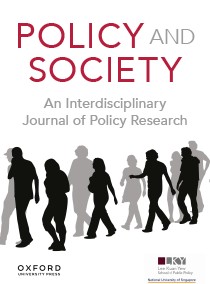How can governments respond to policy bubbles driven by dysfunctional emotions?
IF 6.1
1区 社会学
Q1 POLITICAL SCIENCE
引用次数: 0
Abstract
People sometimes experience intense emotions with maladaptive behavioral consequences (i.e., dysfunctional emotions) that impair their judgment regarding policy problems, policy tools, and/or target populations, leading to the emergence of policy bubbles (i.e., sustained policy over-investment). In this article, I elaborate on three strategies that governments can implement when faced with policy bubbles driven by such emotions: the wait-and-see approach, the emotional containment approach, and the bubble-pricking approach. Based on studies of policy bubbles as well as financial and asset bubbles, I elaborate on the conditions under which each of these policy options may be the appropriate path to follow when encountering such policy bubbles. I conclude that the case for a wait-and-see approach is strong, among other instances, when such bubbles cannot be detected with a reasonable level of confidence while they are still in the initial overinvestment phase; the case for emotional containment is strong when policymakers are interested in preventing such bubbles from getting out of hand, yet they are politically constrained to better calibrate the level of policy investment to the severity of the policy problem; and the case for the bubble-pricking approach is strong when (i) the growth of policy bubbles driven by dysfunctional emotions causes significant harm and (ii) governments do not have at their disposal the necessary tools to keep the harmful effects of such policy bubbles and their burst at a manageable level. An in-depth understanding of context is critical in determining the best course of action.政府如何应对由不正常情绪驱动的政策泡沫?
人们有时会经历强烈的情绪和不适应的行为后果(即,功能失调的情绪),损害他们对政策问题、政策工具和/或目标人群的判断,导致政策泡沫的出现(即,持续的政策过度投资)。在本文中,我详细阐述了政府在面对由这种情绪驱动的政策泡沫时可以实施的三种策略:观望方法、情绪遏制方法和刺破泡沫方法。基于对政策泡沫以及金融和资产泡沫的研究,我详细阐述了在遇到此类政策泡沫时,每种政策选择可能是适当路径的条件。我的结论是,在其他情况下,当此类泡沫仍处于最初的过度投资阶段时,无法以合理的信心水平检测到它们,采取观望态度的理由很充分;当政策制定者有意防止此类泡沫失控时,采取情绪遏制的理由很充分,但他们在政治上受到限制,无法根据政策问题的严重程度更好地调整政策投资水平;当(1)由功能失调的情绪驱动的政策泡沫的增长造成重大伤害,(2)政府没有必要的工具来控制这种政策泡沫的有害影响及其破裂在可管理的水平上时,刺破泡沫方法的理由就很充分了。在确定最佳行动方案时,对环境的深入了解至关重要。
本文章由计算机程序翻译,如有差异,请以英文原文为准。
求助全文
约1分钟内获得全文
求助全文
来源期刊

Policy and Society
Multiple-
CiteScore
18.00
自引率
6.50%
发文量
43
审稿时长
30 weeks
期刊介绍:
Policy and Society is a prominent international open-access journal publishing peer-reviewed research on critical issues in policy theory and practice across local, national, and international levels. The journal seeks to comprehend the origin, functioning, and implications of policies within broader political, social, and economic contexts. It publishes themed issues regularly and, starting in 2023, will also feature non-themed individual submissions.
 求助内容:
求助内容: 应助结果提醒方式:
应助结果提醒方式:


